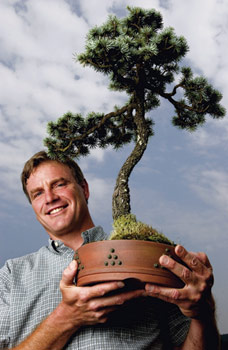Three forces come together in good bonsai — "shin-zen-bi" or truth, essence and beauty. From the simple to the sublime, bonsai is a word that gives form to art, horticulture, science, nature, hobbies, a collector's desire, a garden, a treasure. Bonsai can be thought of as "tray gardening," "potted plant," or "heaven and earth in one container."

But what comes to your mind when you hear the word "bonsai"? Do you immediately think of all things Japanese and get a yearning for sushi? Bonsai has its origins in China, called penzai, incidentally. Did you buy your first bonsai after watching a "Karate Kid" movie, only to later watch it die? Or maybe you're like me: I first thought bonsai was boring and tedious, requiring good hand-eye coordination, which I don't possess. It was an art I just didn't get.
When a fellow soccer mom explained her husband's absence at a game by saying, "He's at a bonsai demonstration," I'm sure my expression said, "He's gone over the edge."
But Arthur Joura has educated me. The curator for the Bonsai Exhibition Garden at the North Carolina Arboretum near Asheville, he remembers one visitor exclaiming as she walked through the exhibit, "I thought these were going to be precious, but they're not precious!" He couldn't have been happier. That is precisely what Joura would like you to know: Bonsai is not your grandmother's china.
I'd add this: The Arboretum's garden isn't for the rarified few that "get" the ancient art of bonsai. It's a garden for everyone. Even me.
True, other Arboretum gardens seem to better fit the nonprofit's mission to promote "the stewardship and enjoyment of the wealth of plant life within the Southern Appalachians" — the Quilt Garden, the National Native Azalea Collection and even the hollies, which are oh-so-Southern evergreens, all make sense. But a bonsai garden? At first, say Arboretum officials, bonsai weren't part of the vision.
But in 1992, George Staples of Butner donated his wife, Cora's, bonsai collection, which numbered about 100 trees. The collection was initially placed in the Arboretum's Production Greenhouse until 2005, when the Bonsai Exhibition Garden was complete and opened to the public. In addition to the Butner collection, the exhibit includes Joura's own creations, as well as other donated "heaven and earth in one container" bonsai. Today, you'll find more than 100 display-quality bonsai in the exhibit.
"Bonsai has a long and colorful history and enjoys a worldwide following of dedicated enthusiasts who hold a variety of ideas about the subject," you'll read on the Arboretum's Web site. This is a respectful and polite nod to those who hold dearly the 1,000-year-old tradition.
Honoring that tradition, the Arboretum collection offers its fair share of Chinese elms and Japanese maples — the preferred and typical bonsai plants. But you'll also find Eastern white pine, red maple, Virginia creeper (in a copper basin that was locally made) and American hornbeam. We're familiar with these Southern plants, and this is one reason you'll see bonsai at the Arboretum.
Bonsai also traditionally places great emphasis on the supposed age of the tree. Yet the Arboretum collection is relatively young. Many specimens have no numerical age noted. Instead, in the Arboretum's words, "Emphasis is placed on artistic design, along with the health and botanical interest of each specimen."
So you're not going to find ancient trees (a bonsai tree can live, if properly cared, longer than its counterpart in the wild). But you'll find a variety of plants and carefully crafted landscape scenes: Aunt Martha's Garden, Mount Mitchell and Roan Mountain, to name a few. These and other landscapes aren't just about the trees but the understory too. Shrubs like azaleas, herbs like creeping thyme, and even sedums create a sense of place in a small bonsai design. As Joura says, "When looking at a landscape, you'll want to shrink yourself down and put yourself in it."
The Bonsai Exhibition Garden itself — with its pavilion, dry stream bed, landscaping that includes American, European and Asian plantings — are worth the visit alone. So that might answer questions as to why we have bonsai in Western North Carolina — but maybe the more appropriate question is, why not?
From Friday, Oct. 9, through Sunday, Oct. 11, bonsai clubs from a six-state region will be at the Arboretum, vying for coveted red ribbons and other awards. The expo includes demonstrations, displays from the clubs, and a talk from internationally known bonsai artist Kathy Shaner. Vendors will be selling their bonsai wares, and food and excitement will abound. There will also be ikebana (flower-arranging) demonstrations and workshops. For more information, visit www.ncarboretum.org.
[Cinthia Milner lives in Leicester.]



I am experimenting with bonsai and would like to know of any sources of 2 to 3 cu. ft. bales of sphagnum moss since I’ve seen this used as a successful medium for bonsai trees.
Also since I use a bonsai medium I make up myself I would be interested in the formula for the medium you use if you can release it.
Thanks for any assistance.
David
David, I will forward your question to some bonsai people that I know and also Arhur Joura. Maybe someone will post on here as well.